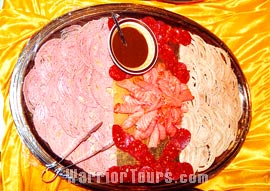Chinese Cuisine

![]() Eight cuisines
Eight cuisines
Introduction with a visual restaurant full of delicious food and impart you the most important cuisine systems.
|
|
|
![]() Minority cuisines
Minority cuisines
information on a few popular minority foods, although most minority diets are worth trying, including Hui Cuisine, also known as Muslim Food, Tibetan Cuisine, Miao Cuisine, Mongolian Cuisine and Zhuang Cuisine.
![]() Food culture
Food culture
Chinese culture lying under delicious food: Chinese people use chopsticks instead of knives and forks that are used by westerners. Decent behaviors on table is important, and the main table manners include not sticking the chopsticks to other people, not tapping on the bowl or plate with chopsticks, and not fishing over and deboning the fish on your own.
![]() Medical Cuisine
Medical Cuisine

Chinese medical cuisine seems to be Chinese monopoly. It will help those who do not like drugstore and hospital.
The medical cuisine is not the simple summation of food and herbal medicines, but it is created with extra care according to traditional Chinese medical theory. It tastes delicious, and can help cure and prevent illnesses and maintain health. Originating from 'Medicine and food being of the same origin', Chinese medical cuisine formed after the Qin (221 BC-206 BC) and Han (206 BC-220 AD) dynasties and flourished in the Ming (1368-1644) and Qing (1644-1911) dynasties. In the 1950s, it declined and in the 1980s, it grew back along with the implementation of reforms and opening-up policies in China.
In China, people contend that food tonic is much better than medicine tonic in building up one's health. In the famous Chinese medical book Shen Nong's Pharmacopoeia (Shen Non Ben Cao Jing), a lot of materials were recorded both as medicines and foods, including Chinese date, sesame, yam, grape, walnut, lily, ginger and wheat germ. Many medical food prescriptions recorded in medical books still have important applications today, for example, food taboos for pregnancy, nursing, and drinking, as well as for all kinds of medical porridges.

Medical food has a variety of materials to choose from and features unique flavors. Generally herbal materials are more commonly used after reducing or getting rid of their strong odors. Different herbs taken according to doctors' instructions nourish individuals with different physical needs. Slow cooking methods such as stewing, braising and simmering, are applied to extract more herbal juice without destroying the medicinal effect.
Along with the development of science and technology, the variety of Chinese medical food is increasing year by year based on traditional techniques. Tins, sweets, beverages and many other forms of medical food have come into daily life, among which some are helpful to diabetics, obesity patients and sufferers of cardiovascular disease. Some are good for athletes, performers and miners, some benefit the elderly to prolong life and maintain health, and some can promote the growth of children.
Typical Chinese medical cuisines include Ginger and Mutton Soup, Soup of Chinese Angelica root, Huangqi (Membranous Milk Vetch), Pork Simmered with Lotus Seed and lily, Pig Kidney Stewed with Eucommia Bark, and so on.

